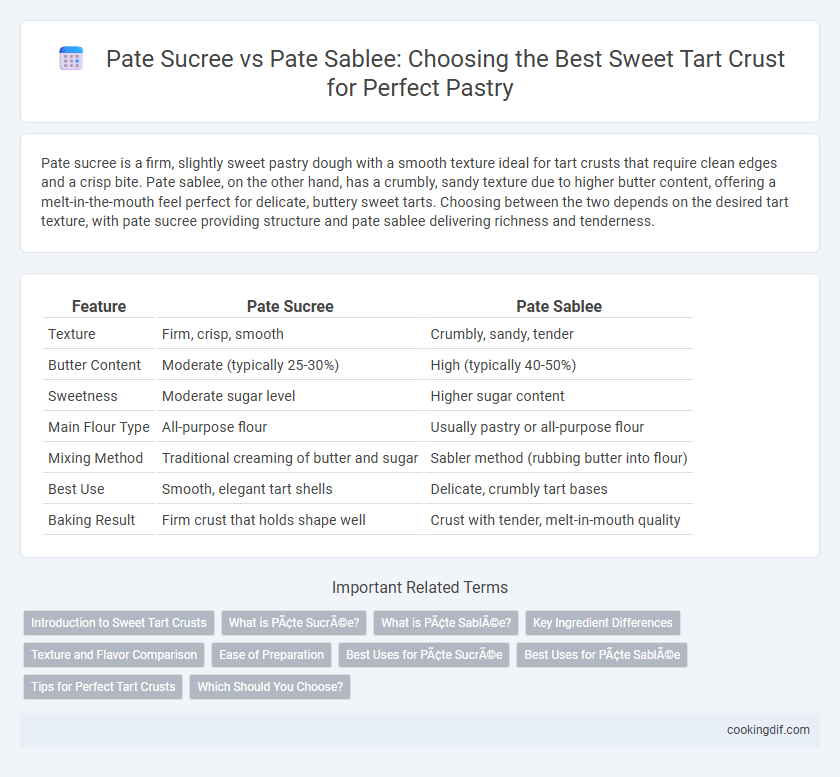Pate sucree is a firm, slightly sweet pastry dough with a smooth texture ideal for tart crusts that require clean edges and a crisp bite. Pate sablee, on the other hand, has a crumbly, sandy texture due to higher butter content, offering a melt-in-the-mouth feel perfect for delicate, buttery sweet tarts. Choosing between the two depends on the desired tart texture, with pate sucree providing structure and pate sablee delivering richness and tenderness.
Table of Comparison
| Feature | Pate Sucree | Pate Sablee |
|---|---|---|
| Texture | Firm, crisp, smooth | Crumbly, sandy, tender |
| Butter Content | Moderate (typically 25-30%) | High (typically 40-50%) |
| Sweetness | Moderate sugar level | Higher sugar content |
| Main Flour Type | All-purpose flour | Usually pastry or all-purpose flour |
| Mixing Method | Traditional creaming of butter and sugar | Sabler method (rubbing butter into flour) |
| Best Use | Smooth, elegant tart shells | Delicate, crumbly tart bases |
| Baking Result | Firm crust that holds shape well | Crust with tender, melt-in-mouth quality |
Introduction to Sweet Tart Crusts
Pate Sucree and Pate Sablee are two foundational doughs used for sweet tart crusts, each offering distinct textures and flavors. Pate Sucree is a crisp, buttery dough with a smooth surface, commonly used for elegant dessert tarts due to its firm structure and slight sweetness. Pate Sablee, known for its crumbly, sandy texture, provides a tender, melt-in-the-mouth experience that enhances fruit-forward and rich filling combinations.
What is Pâte Sucrée?
Pate Sucree is a French sweet tart dough known for its smooth, tender texture and subtle sweetness, made by combining butter, sugar, eggs, and flour into a cohesive dough. Its higher fat and sugar content compared to pate sablee results in a firmer yet crumbly crust that holds fillings well without becoming soggy. Commonly used in classic tarts like fruit or chocolate tarts, pate sucree provides a balanced base that enhances the flavor of sweet fillings.
What is Pâte Sablée?
Pate Sablee is a French sweet tart crust known for its crumbly, sandy texture that results from a higher butter-to-flour ratio and minimal handling to prevent gluten development. This pastry dough incorporates powdered sugar and egg yolks, contributing to its rich flavor and tender consistency, making it ideal for delicate tart shells. Commonly used in classic French pastries, Pate Sablee provides a crisp but tender base that contrasts beautifully with soft, sweet fillings.
Key Ingredient Differences
Pate Sucree contains butter, sugar, egg yolks, and flour, creating a tender, crisp texture ideal for delicate tart crusts. Pate Sablee includes butter, sugar, flour, and egg yolks as well, but uses a method that produces a sandy, crumbly texture due to the higher butter-to-flour ratio. The key ingredient difference is the quantity of butter and sugar, which significantly influences the dough's texture and sweetness for sweet tart bases.
Texture and Flavor Comparison
Pate Sucree yields a crisp, firm texture with a rich, buttery flavor ideal for structured tart shells, while Pate Sablee offers a tender, crumbly texture with a more delicate sweetness and a melt-in-the-mouth feel. Pate Sucree's dough is smoother due to its butter-to-flour ratio and sugar content, enhancing caramelization during baking, whereas Pate Sablee's higher butter content produces a sandy, fragile crumb. Flavor profiles differ as Pate Sucree delivers pronounced sweetness balanced with a slight chewiness, contrasting with Pate Sablee's subtly nutty and melt-away richness, influencing the overall dessert experience.
Ease of Preparation
Pate Sucree offers easier preparation due to its straightforward mixing process, combining butter, sugar, egg yolks, and flour without overworking the dough. Pate Sablee requires more careful handling to maintain its sandy texture, as overmixing can cause toughness in the crust. For beginners or quicker tart crusts, pate sucree is typically the preferred choice because of its forgiving nature during preparation.
Best Uses for Pâte Sucrée
Pate Sucree is best suited for delicate sweet tart crusts requiring a firm yet tender texture that holds shape during baking. Its buttery, slightly crisp profile pairs perfectly with rich custards, fruit fillings, and cream-based tarts, providing a refined base without overpowering flavors. Ideal for professional and home bakers, Pate Sucree excels in recipes like classic French fruit tarts and chocolate ganache tarts.
Best Uses for Pâte Sablée
Pate sablee, known for its crumbly and sandy texture, is best suited for delicate sweet tart crusts where a tender bite is desired, such as fruit tarts and custard-based desserts. Its higher butter content and coarser sugar create a rich, melt-in-the-mouth quality that complements fresh berries and creamy fillings without overpowering them. This dough is less elastic than pate sucree, making it ideal for delicate pastries that require a fragile, crumbly crust.
Tips for Perfect Tart Crusts
Pate Sucree offers a firm, sweet base ideal for holding moist fillings without losing shape, while pate sablee provides a crumbly, delicate texture that melts in the mouth. For perfect tart crusts, chill the dough thoroughly before rolling to prevent shrinking and ensure even baking. Use minimal handling to maintain tenderness, and blind bake with pie weights to achieve a crisp, golden crust.
Which Should You Choose?
Pate Sucree offers a rich, buttery texture with a firmer, more structured crust ideal for holding delicate fillings, while Pate Sablee provides a crumbly, melt-in-your-mouth quality perfect for adding a tender crunch to tarts. Choosing between the two depends on the desired texture and the type of filling; Pate Sucree is best for smooth, creamy fillings that require support, whereas Pate Sablee complements softer, fruit-based fillings with its sandy consistency. Considering these differences ensures the perfect balance of flavor and texture in your sweet tart crust.
Pâte Sucrée vs Pâte Sablée for sweet tart crusts Infographic

 cookingdif.com
cookingdif.com